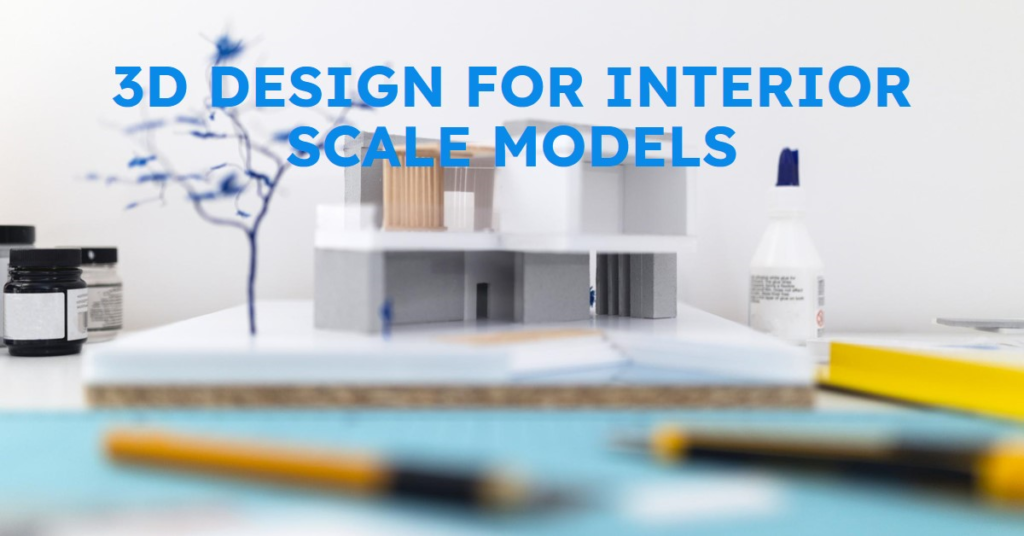
Table of Contents
1. Introduction: The Evolution of Interior Scale Models
How 3D Design Is Used For Creating Scale Models Of Interiors – Interior scale models have long been a staple in the design and architecture industries, providing tangible representations of spatial layouts, furniture arrangements, and design concepts. Traditionally, these models were painstakingly crafted by hand, using materials such as wood, foam, and cardboard. However, with advancements in technology, 3D design has revolutionized the way interior scale models are created, offering greater precision, flexibility, and realism. In this guide, we’ll explore how 3D design is used to create scale models of interiors, from conceptualization and modeling to rendering and presentation.
2. Conceptualization: From Ideas to Digital Blueprints
The process of creating a scale model begins with conceptualization, where designers brainstorm ideas, gather inspiration, and sketch out rough concepts. In the digital realm, this phase often involves using 3D design software such as SketchUp, Blender, or Autodesk Revit to create digital blueprints of the interior space. Designers can experiment with different layouts, furniture arrangements, and decorative elements, refining their ideas until they achieve a concept that aligns with the client’s vision and requirements. By utilizing 3D design tools, designers can quickly iterate on their designs, making adjustments and revisions in real-time to ensure the final scale model accurately reflects the intended aesthetic and functionality of the space.
3. Modeling: Bringing Concepts to Life
Once the conceptualization phase is complete, designers move on to the modeling stage, where they translate their ideas into three-dimensional representations. Using 3D modeling software, designers create virtual replicas of the interior space, including walls, floors, ceilings, and architectural features. They also model furniture, fixtures, and other decorative elements, placing them within the virtual environment to simulate the final layout. By meticulously detailing each component of the interior space, designers can achieve a high level of accuracy and realism in the scale model, allowing clients to visualize the finished project with clarity and precision.
4. Texturing and Material Selection: Adding Depth and Realism
In addition to modeling, texturing and material selection play a crucial role in enhancing the realism and visual appeal of interior scale models. Designers use 3D design software to apply textures, colors, and materials to surfaces, creating lifelike representations of wood, stone, fabric, and other materials. By carefully selecting and configuring materials, designers can evoke specific moods, aesthetics, and atmospheres within the scale model, from cozy and inviting to sleek and modern. Texturing also allows designers to experiment with different finishes and patterns, helping clients visualize how materials will look and feel in the actual space.
5. Lighting and Rendering: Bringing Models to Life
Lighting is a critical aspect of interior design, and it plays an equally important role in creating realistic scale models. Designers use 3D rendering software to simulate various lighting conditions within the virtual environment, from natural sunlight streaming through windows to artificial lighting fixtures illuminating the space. By adjusting parameters such as intensity, color temperature, and directionality, designers can create compelling visualizations that accurately represent how light interacts with the interior elements. Rendering software also allows designers to add effects such as shadows, reflections, and ambient occlusion, further enhancing the realism and depth of the scale model.
6. Presentation and Visualization: Communicating the Design Vision
Once the scale model is complete, designers present it to clients using a variety of visualization techniques. This may include still images, 360-degree panoramas, virtual reality experiences, or even animated walkthroughs. By leveraging these visualization tools, designers can effectively communicate their design vision to clients, allowing them to explore the space from different perspectives and understand how each element contributes to the overall aesthetic and functionality. Visualization also helps clients make informed decisions about design choices, materials, and finishes, ensuring that the final result aligns with their expectations and requirements.
7. Collaboration and Iteration: Fine-Tuning the Design
Throughout the design process, collaboration and iteration are key to achieving a successful outcome. Designers work closely with clients to gather feedback, address concerns, and make adjustments to the scale model as needed. By fostering open communication and a collaborative mindset, designers can ensure that the final design meets the client’s needs and exceeds their expectations. Iteration also allows designers to explore different design options, experiment with new ideas, and refine the scale model until it accurately reflects the client’s vision for the space.
8. Accessibility and Versatility: Reaching a Wider Audience
One of the primary benefits of using 3D design for creating interior scale models is the accessibility and versatility it offers. Unlike traditional physical models, which are often expensive and time-consuming to produce, digital scale models can be easily shared and distributed to clients, stakeholders, and collaborators around the world. Designers can create digital presentations, shareable links, or downloadable files that allow viewers to explore the scale model at their own pace, from the comfort of their own home or office. This accessibility not only facilitates communication and collaboration but also expands the reach of the design, allowing a wider audience to engage with and provide feedback on the project.
9. Accuracy and Precision: Ensuring Design Integrity
Another advantage of using 3D design for creating scale models is the level of accuracy and precision it offers. With digital tools, designers can ensure that every aspect of the scale model is measured and aligned with the architectural plans, ensuring design integrity and minimizing errors or discrepancies. This level of precision is particularly important in complex or highly detailed projects, where even minor deviations can have significant consequences. By leveraging 3D design software, designers can create scale models that accurately represent the spatial layout, proportions, and dimensions of the interior space, providing clients with a clear and realistic depiction of the final design.
10. Conclusion: Harnessing the Power of 3D Design for Interior Scale Models


In conclusion, 3D design has revolutionized the process of creating interior scale models, offering designers greater flexibility, precision, and realism than ever before. By leveraging digital tools for conceptualization, modeling, texturing, lighting, rendering, presentation, collaboration, and iteration, designers can create scale models that accurately reflect the client’s vision and requirements. From conceptual sketches to photorealistic renderings, 3D design enables designers to bring their ideas to life in vivid detail, allowing clients to visualize the final result with clarity and confidence. As technology continues to evolve, the role of 3D design in interior scale modeling will only continue to grow, empowering designers to push the boundaries of creativity and innovation in the field of interior design.


